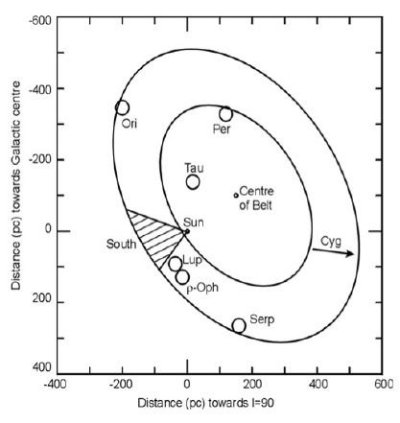O que é o disco de Gould e como se poderia explicar a manutenção da sua estrutura ao longo do tempo. Poderá a matéria escura ter um papel determinante neste processo?
A cintura de Gould é um disco de estrelas jovens e quentes (tipos espectrais O e B) e nuvens moleculares onde se formam novas estrelas. Está localizado junto à parte exterior do braço de Orion sendo que o seu diâmetro é de aproximadamente 3000 anos-luz, apresentando em relação ao plano galáctico uma inclinação de aproximadamente 20 graus. Entre os seus componentes destacam-se algumas das estrelas mais brilhantes das constelações de Orion, Cão Maior, Puppis, Carina, Centauro e Escorpião. O nosso Sol está situa-se a cerca de 325 anos luz do centro do disco e cerca de 40 anos luz acima do plano equatorial do disco.

Fig. 1 - Esquema do disco de Gould mostrando a posição relativa do Sol. As distâncias estão assinaladas em parsec (1pc = 3.26 anos luz) / Gould disk layout, showing the Sun's relative position to it. Distances are marked in parsec, with 1 pc = 3.26 light-years [Credit: Joint Astronomy Center].
[https://www.daviddarling.info/encyclopedia/G/GouldBelt.html]
A massa da matéria que compõe o disco de Gould é da ordem de um milhão de massas solares. Poderá ter entre 30 e 50 milhões de anos. Contudo a sua origem não é clara. Simulações numéricas apontam para uma possível colisão entre uma nuvem de gás com cerca de um milhão de massas solares e um aglomerado de matéria escura com uma massa 10 vezes superior. Este estudo publicado no artigo Dark impact and galactic star formation: Origin of the Gould belt pode ser consultado em: https://arxiv.org/abs/0906.5117.
What is the Gould disk, and how can we explain its structure surviving for a long period of time? Could dark matter have a role in this process?
The Gould Belt or disk is a disk of young, hot stars (spectral types O and B) and molecular clouds, where new stars form. It's located near the outer part of the arm of Orion and its diameter is approximately 3 000 light-years, presenting an inclination of approximately 20º in relation to the galactic plane. Among its components, some of the brightest stars in the constellations of Orion, Canis Major, Puppis, Carina, Centaurus and Scorpion stand out. Our Sun is located about 325 light-years from the center of the disk, and about 40 light-years its equatorial plane (see Fig. 1).
The mass of the matter that makes up the Gould disk is of the order of a million solar masses. It could be between 30 and 50 million years old. However, its origin is unclear. Numerical simulations point to a possible collision between a gas cloud with about a million solar masses and a cluster of dark matter with a mass 10x greater. This study, published in the article Dark impact and galactic star formation: Origin of the Gould belt, can be checked at: https://arxiv.org/abs/0906.5117.
